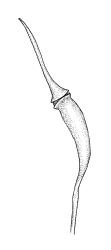- = Helicodontiadelphus Dixon, J. Bot. 74: 5 (1936)
Eriodon was created by Montagne to accommodate a Chilean species of Brachytheciaceae characterised in part by extremely long (equalling half the capsule length) peristome teeth and a long and finely rostrate operculum. Brotherus (1925) recognised two species of Eriodon, both South American. Other species, to a total of nine, have been described in or transferred to the genus. Buck (1981b) transferred three species of these nine to other genera (disposed in three separate families). The single N.Z. species has been treated as a Rhynchostegium by Hedenäs (2002), but his proposed placement is not followed here, mainly due to sporophyte morphological differences between the genera.
Buck (1981b) characterised the genus as “smallish subcomplanate plants with ovate-lanceolate, unicostate leaves, margins serrulate throughout, linear laminal cells, alar cells differentiated only in the extreme basal angles, an autoicous sexual condition and suberect capsules. The exostome is papillose, with the papillae arranged in horizontal rows at the base of the teeth. The endostome is papillose throughout with a relatively high basal membrane and narrow segments. The operculum is long-rostrate.”
Although it was originally described in Rhynchostegium, the peristome of Eriodon cylindritheca differs strongly from both other N.Z. species of that genus and from the European type species (R. confertum (Dicks.) Schimp.). In E. cylindritheca (and the one specimen of E. conostomus available for examination), the exostome teeth are pale, linear, bordered below, not shouldered and coarsely papillose-baculate throughout on the outer surface. The papillae are arranged in transverse rows on the lowermost plates. In both species the endostome is papillose-baculate throughout, arises from a basal membrane (which is 200–240 µm high in the type species), and has very long, linear segments. Cilia have not been seen in the type species, but they are also sometimes weakly developed in E. cylindritheca.
The description of E. cylindritheca, below, is presented here as representative of the genus.
| Category | Number |
|---|---|
| Indigenous (Non-endemic) | 1 |
| Total | 1 |




